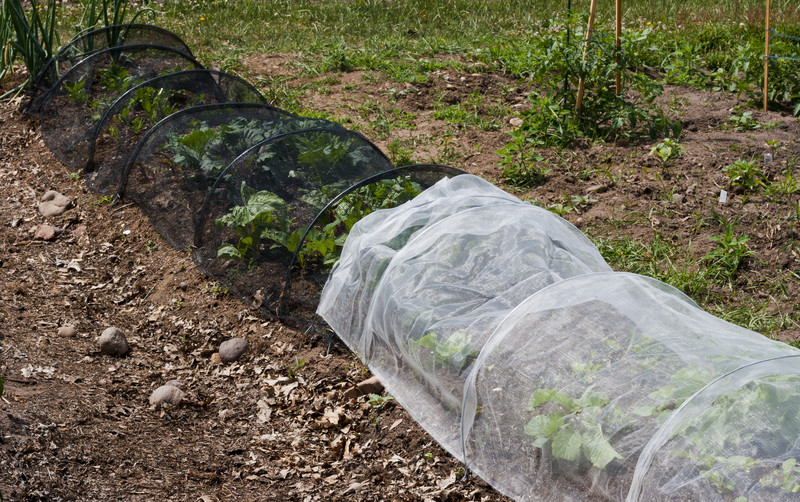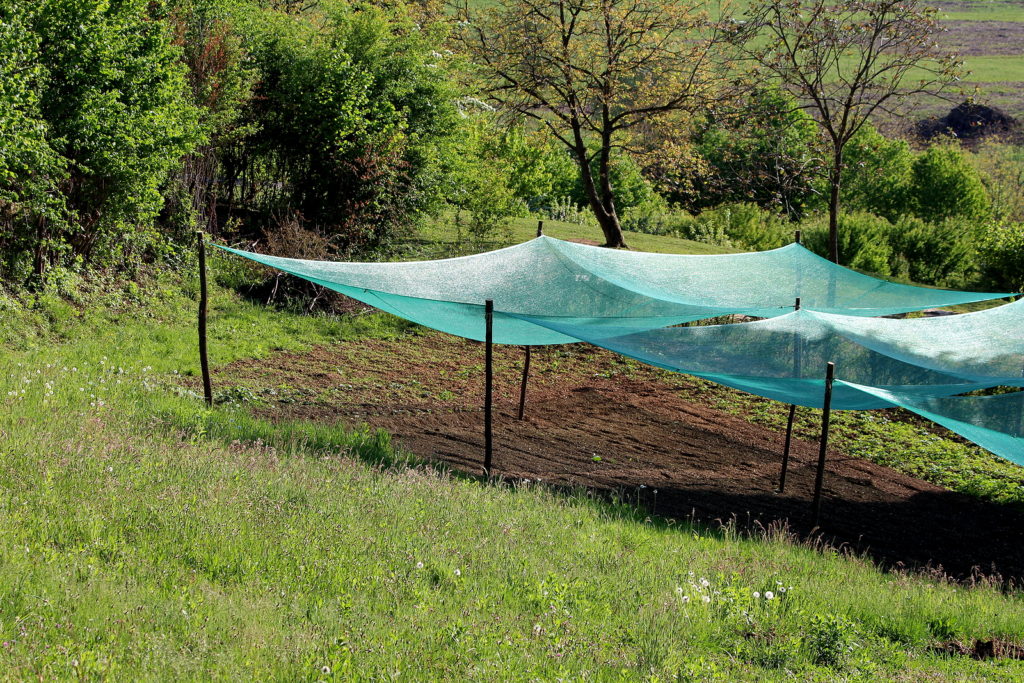Vegetable crops should be protected from temperatures much greater than 95°F (35°C). Most vegetables will be stressed when temperatures rise to 100°F and many will die in sustained temperatures greater than 110°F.
Signs of heat stress in vegetables include wilting at the ends of new growth, blossom drop, leaf drop, and sunburn of leaves and fruit Sunburn is characterized by dull yellow patches in the center of leaves and on fruit; these patches may turn white and thin as plant tissue dies.
When temperatures rise to greater than 95°F for more than a day or two most warm-weather crops will stop growing and setting fruit. (The same happens to cool-weather crops at about 80°F.)
If high temperatures persist, it is best to protect vegetables from sun and heat. The best course of action is to keep the direct sun off of foliage and to lower the temperature of plants. Shade can lower plant and soil temperatures by as much as 10°F.

Ways to use shade to protect garden plants
• Use shade cloth to protect plants. Use plant stakes or fiberglass or poly hoops to build a framework over plants or planting beds and drape shade cloth over the frame much as you would drape a tablecloth over a table. In addition to protecting plants from the mid-day sun, angle the frame and cloth to protect plants from the setting sun as well. Avoid completely covering plants; allow space of 2 or 3 feet for air to enter and move easily around the plants.
• Attach dark-colored shade cloth to the plant protection framework; do not allow dark shade cloth which more readily absorbs heat to sit directly on plant foliage.
• White- or light-colored shade cloth can be placed closer to plant foliage because it reflects away heat in addition to providing shade.
• Summer weight garden fabric made of polypropylene or row covers made of muslin or cheesecloth can sit directly on plant foliage. Lightweight row covers can block as much as 85 percent of sunlight while lowering the temperature and trapping humidity around the plants.

• Peaches, apples, and other fruits–even tomatoes, peppers, and eggplants–hanging on the ends of branches can be protected by placing paper or cloth sacks over them if hanging a shade cloth over the plant is not doable. Grapes can be protected by slipping a paper bag over fruit clusters and stapling or taping the end closed.
• Plants located on the south or west end of the garden can be protected by erecting a temporary shade framework. Hang shade cloth from a line between two posts much as you would towels from a clothesline or place a section of picket fence between two stakes; set the section of the fence against the stakes at a 45-degree angle.
• Garden umbrellas can be stationed near vegetable beds during hot spells to keep the sun at bay. A laundry basket or bushel basket turned upside down can protect small crops. A plastic seed or plant flat can be placed upside down over seeded beds or just germinated seedlings.
• Cut branches from palm trees, palmetto trees, or evergreen trees can be stuck cut ends in the soil along the west or south side of crop rows.
• Two or more rows of sunflowers, sunchokes, corn, or other tall plants can be planted alongside garden beds where afternoon sun and heat are a perennial summer problem. Tall crops are commonly planted on the north side of gardens, but in hot summer regions tall crops on the west or south side of the garden may be the prudent course.

Shade cloth hoop tunnel uses
Hoops can also support floating row covers to keep insects out of vegetable beds. Use a light horticultural cloth to shade plants, sheet plastic to protect from early frosts or to warm the beds in spring, or netting to keep birds from eating your crops.
Construction wire, chicken wire, and fence wire also can be used to make row- or bed-wide tunnels. Arch the wire over the row or bed, secure the wire with stakes, and cover it with shade cloth or floating row cover cloth.
Shade tunnels can also be fashioned by bending stiff wire into loops, pushing the wire into the soil 1 to 2 feet, and stretching shade cloth or horticultural cloth over the hoops.
For seed beds and seedlings, you can make temporary hoop tunnels using wire coat hangers.
Dark shade cloth material which can hold heat should be attached to hoops well above plants to allow air to move over the plants easily. White shade cloth can lay closer to plant foliage—even directly on them—because it reflects heat.
Shade is essential for most vegetables once temperatures climb above 100°F. The shade will protect foliage and fruit from sunburn and stress. Watering can help cool plants, but when there is a prolonged heat wave watering every day can run the risk of drowning plant roots.
How to make a shade hoop tunnel
To construct a 5-foot-long shade tunnel, you will need three 4-foot sections of 1-inch diameter flexible PVC pipe and six 10-inch metal stakes narrow enough to fit into the ends of the pipes.
- Put the stakes into the ends of the pipe and then arch the flexible pipe over the bed and drive the stakes into the ground or create hoops.
- Cover the half-hoops with shade cloth or horticultural fabric.
- Secure the fabric in place with garden staples, soil, boards, or stones on the ground or with clothespins attached to the pipe.

Other ways to protect plants from heat
Watering
In addition to shading plants, keep a close watch on soil moisture and evaporation. Keep the soil around summer crops evenly moist. Drying soil down to 2 or 3 inches is acceptable for established crops but not for shallow-rooted crops. If the soil is not moist at 4 inches below the surface, give plants a slow, deep watering. Avoid over-watering; plant roots can suffer and even drown if soil air is depleted.
Mulching
Stem soil moisture evaporation and keep the soil temperature down by mulching. Apply two to three inches of dried leaves or compost around plants at midsummer to slow soil moisture evaporation.
Soil temperatures of greater than 85°F can slow plant growth; mulch will moderate soil temperature by keeping the sun’s rays from directly warming the soil. The temperature of soil under the mulch will change much more slowly.
Related articles:
Watering Vegetables in Hot Dry Weather.
Vegetable Garden Organic Pest Control
Garden Planning Books at Amazon:
- Vegetable Garden Almanac & Planner
- Kitchen Garden Grower’s Guide Vegetable Encyclopedia
- Vegetable Garden Grower’s Guide
- Tomato Grower’s Answer Book















